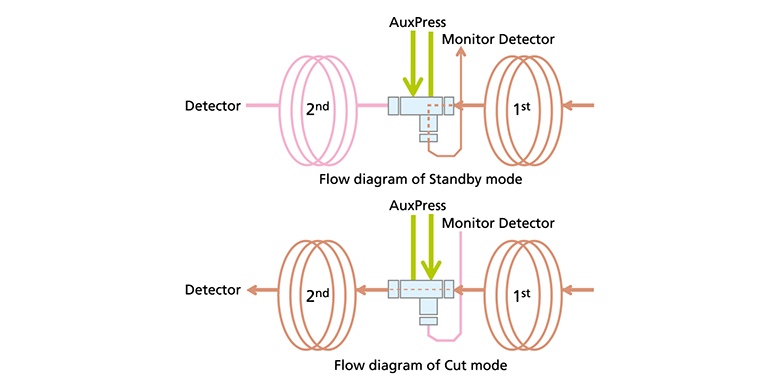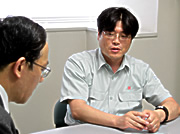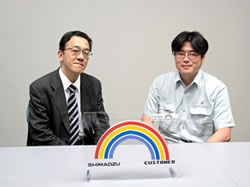
Advanced Flow Technology Series

INDUSTRY
Hydrocarbon Processing Industry (Petrochemical, Chemical)
KEYWORD
INTRODUCTION SERVICE&PRODUCTS
Advanced Flow Technology Series
When Shimadzu was developing the multidimensional (MD) GC, the staff at Takasago International Corp. provided great assistance in helping us complete development of the system by evaluating the instrument, not only from a functional standpoint, but in other aspects as well, including convenience and instrument stability. We talked to Mr. Yaguchi, who is fully utilizing the MDGC in the research of optically active fragrances, etc., regarding the hardships he encountered while the instrument was being developed, and the status of the instrument in its present utilization.

Yoshihiro Yaguchi
Senior Scientist
Analytical Technology Resarch
Corporate Research &
Development Division
*Affiliates and titles of the interviewee are current as of the time of reporting.
Takasago International Corporation
URL
http://www.takasago.com/en/index.html
What prompted your company to request the development and customization of the multidimensional GC system (MDGC) in 2003?

The original MDGC we were using was commonly used in Europe at that time for fragrance analysis. However, it was a very complicated instrument, and unless someone was very familiar with its operation, it was very difficult to use effectively. Changing the column and other basic instrument maintenance required a lot of time and technical expertise. After years of use, it finally deteriorated, so it was necessary to replace it with another MDGC. By that time I wanted an instrument that would be easier to use from the standpoints of both hardware and software, so I looked for a manufacturer who would be willing to accept special customization requests.
So you approached Shimadzu with your proposal, and we decided to create an instrument together. We modified various types of hardware and switching elements many times, and your company actually used and evaluated them. We also custom designed the software to make it easy to use with MDGC. Can you tell us about any of the hardships you encountered at that time?
Once, I set up a 10-line batch analysis, started the analysis and went home for the night. When I arrived at work the next day, I found that the analysis had stopped after completing only 3 lines of the batch analysis. That was a severe blow, because we were really pressed for time. On-going consultation with the technicians as to what might be causing interruption of the batch analysis gradually resulted in improved operation. Of course, problems like the unexpected interruption of analysis no longer occur.
There was a considerable difference in the hardware and software from the time of initial development to when the MDGC was completed. In what way were these changes favorable?

Since the MDGC software is based on the improved Solution series of Shimadzu's workstation, it is extremely easy to use. There was absolutely no sense of discomfort with the new MDGC software because of our familiarity with the Solution series software gained through our long experience with the single-column GC and GC/MS software.
Is there anything further that you think should be improved in the present MDGC system?
I think there is sufficient functionality already built into the system. There may be some minor improvements that could ease routine operations, for example, more durable screw threads, etc. But as a system, it has no shortcomings and is easy to use.
Then, you could say that its degree of completion is high?
Yes, that's correct.
Thank you. In what kind of configuration are you using it presently? And, if possible, could you tell me about the purpose of your analysis?

In our configuration, the first step consists of an FID detector with switching between an AOC-20i (autoinjector) and a TD (thermal desorption system). The second step is used with an MS attached. The system is often used for qualitative and chiral analysis. Since a chiral compound in a natural substance may not necessarily be a racemic compound, the MDGC is used to determine the ratio of the d form to the l form, for example, a ratio of 70:30 or 80:20, etc. There are many compounds that are known to have different aromas, depending on the content ratios of the d form and l form. For example, a variation of a compound consisting of 100% of the d form and another with 100% of the l form may have completely different aromas. Our company uses asymmetric synthesis and enzyme reactions to obtain optically active aroma blends referred to as Chiraroma®.
In other words, these optically active aromas are mixed to achieve aromas that are similar to natural ones. By the way, how do you use the single-column GC and GCMS as distinguished from the MDGC?
The single-column GCMS is used almost entirely for general-purpose and routine analysis with a fixed method, while the MDGC is mainly used for analyses in which the methods are constructed painstakingly, step by step. When we wish to obtain high-quality, more comprehensive data, we often rely on the MDGC.
When you say high-quality data, do you mean that the peaks are acquired with certainty? Or, do you mean peaks that are actually of high purity.

Interview with YOSHIHIRO YAGUCHI
There is really not much to worry about when using a single-column GC and GCMS to analyze targets of high purity, but when analyzing fragrance compositions, as many as one or two hundred peaks may be detected. At that point, extracting only the targeted substance from those peaks and obtaining the necessary information requires painstaking fractionation and purification when using a single-column GC and GCMS. When looking at both stereoisomers (d form, l form) of target compounds in a natural substance, it is not practical to eliminate all the surrounding material before conducting the analysis. But it is extremely easy to obtain the targeted information from within a complicated mixture using the MDGC.
Could you tell me what kind of GC analytical conditions you are actually using?
We normally use a Wax series column with high polarity in the first step GC, while in the second step GC we use a column for separating chiral optical isomers when conducting chiral analysis. For qualitative analysis, we sometimes use this in combination with a relatively nonpolar column. Since there are compounds that have an extremely strong aroma even at low concentrations, it can be difficult to identify a compound in the course of qualitative analysis due to the intensity and quantity of the fragrance. In such a situation, identification may not be easy if analysis is conducted with the single-column GCMS, so we use it in conjunction with GC/O (sniffing) data.
Are you obtaining the kind of results you expected from the Shimadzu MDGC? Do you have any requests regarding any of our products you are using?

Although not directly related to the MDGC system, we can obtain very clean chromatograms, method creation is simple, and analysis of the acquired data is very well addressed with GCMSsolution, which is very easy to use. I would have to say that at this point, there are no deficiencies from the standpoint of functionality. Compared to the GCMS control software of other manufacturers, it is an easy-to-use system. In particular, the postrun analysis function is excellent. However, if there were something to say about GCsolution and GCMSsolution, I think there should be more uniformity between the two interfaces. There are quite a few differences in menu arrangement and rules in these two interfaces. A function that is present in one might not be present in the other, or they might be different, or perhaps, accessed from a different menu. Because of such inconsistencies, an analyst who frequently uses both software packages may be confused.
Thank you for your valuable comments. We will incorporate your advice in our future development. Regarding future product development, aside from existing products, is there any such product you would like to see available or any such item you wish could be developed?
My wish is for innovative GC technological development. I am looking forward to seeing the new, next generation GC technology, with new knowhow and new technology that is exciting enough to capture everyone’s attention. Of course, I think Shimadzu’s developers are capable of doing this.
Can you share with me your opinions and any requests of Shimadzu Corporation or regarding our analytical equipment overall?

There is so much that it is difficult. I think that the relationship between hardware and software is still very important. Even if the hardware is good, there is not much chance that users will be able to use it if only hardware specialists can figure out how to use it. So, it is very important that the interface be very approachable, that it is easy to understand, and that operation menus and commands be where one would expect them to be. Even if you search for what you want to do, not being able to find it is extremely stressful for a user. If the software is not user-friendly, regardless of the number of functions and high overall performance, there is no way to take advantage of these merits. Of course, it is good to carefully read the manual, but unless the operation menus and commands can be quickly and easily located, the software will be difficult to use. Yes, I believe that easy-to-use software is very important.
I hope, in the future, we can develop good products while relying on your frank opinions. I am proud that the MDGC became a fine product thanks to the assistance of your company. It is a pleasure working with you.
I hope to be of help to you. Thank you very much.

Roses were in full bloom at the rose garden on Takasago International's premises.

Development of this instrument originated with an inquiry from Takasago International in 2003, asking if Shimadzu would be interested in developing an instrument capable of better heart-cut analysis. Since fragrance companies have some of the most demanding applications, it was necessary to pay very close attention to design of the hardware; design of the complex flow line was very tough. In addition, it was essential that easy-to-use software be developed. In particular, the requirement that MDGCsolution control two Solution software modules simultaneously made development extremely difficult, with the items to be checked increasing exponentially. In the end, the completed system featured both hardware and software that are superior to those of other companies, and the hardship encountered during development only served to deepen our sense of reward. In the future we will make further efforts to develop products that are easy to use for customers.